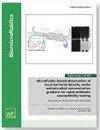Acoustophoresis of monodisperse oil droplets in water: Effect of symmetry breaking and non-resonance operation on oil trapping behavior
IF 2.6
4区 工程技术
Q2 BIOCHEMICAL RESEARCH METHODS
引用次数: 0
Abstract
Acoustic manipulation of particles in microchannels has recently gained much attention. Ultrasonic standing wave (USW) separation of oil droplets or particles is an established technology for microscale applications. Acoustofluidic devices are normally operated at optimized conditions, namely, resonant frequency, to minimize power consumption. It has been recently shown that symmetry breaking is needed to obtain efficient conditions for acoustic particle trapping. In this work, we study the acoustophoretic behavior of monodisperse oil droplets (silicone oil and hexadecane) in water in the microfluidic chip operating at a non-resonant frequency and an off-center placement of the transducer. Finite element-based computer simulations are further performed to investigate the influence of these conditions on the acoustic pressure distribution and oil trapping behavior. Via investigating the Gor’kov potential, we obtained an overlap between the trapping patterns obtained in experiments and simulations. We demonstrate that an off-center placement of the transducer and driving the transducer at a non-resonant frequency can still lead to predictable behavior of particles in acoustofluidics. This is relevant to applications in which the theoretical resonant frequency cannot be achieved, e.g., manipulation of biological matter within living tissues.水中单分散油滴的声震:对称性破坏和非共振操作对油捕集行为的影响
最近,微通道中颗粒的声学处理技术备受关注。油滴或颗粒的超声驻波(USW)分离是一种成熟的微米级应用技术。声流体设备通常在优化的条件下运行,即共振频率,以最大限度地降低功耗。最近的研究表明,要获得声学粒子捕集的有效条件,需要打破对称性。在这项工作中,我们研究了单分散油滴(硅油和十六烷)在微流体芯片中以非共振频率和偏离中心的换能器位置工作时在水中的声泳行为。我们还进一步进行了基于有限元的计算机模拟,以研究这些条件对声压分布和油捕集行为的影响。通过研究 Gor'kov 电位,我们发现实验和模拟获得的捕集模式存在重叠。我们证明,将换能器置于偏离中心的位置并以非共振频率驱动换能器仍可导致声流体中颗粒的可预测行为。这与无法达到理论共振频率的应用有关,例如在活体组织内操纵生物物质。
本文章由计算机程序翻译,如有差异,请以英文原文为准。
求助全文
约1分钟内获得全文
求助全文
来源期刊

Biomicrofluidics
生物-纳米科技
CiteScore
5.80
自引率
3.10%
发文量
68
审稿时长
1.3 months
期刊介绍:
Biomicrofluidics (BMF) is an online-only journal published by AIP Publishing to rapidly disseminate research in fundamental physicochemical mechanisms associated with microfluidic and nanofluidic phenomena. BMF also publishes research in unique microfluidic and nanofluidic techniques for diagnostic, medical, biological, pharmaceutical, environmental, and chemical applications.
BMF offers quick publication, multimedia capability, and worldwide circulation among academic, national, and industrial laboratories. With a primary focus on high-quality original research articles, BMF also organizes special sections that help explain and define specific challenges unique to the interdisciplinary field of biomicrofluidics.
Microfluidic and nanofluidic actuation (electrokinetics, acoustofluidics, optofluidics, capillary)
Liquid Biopsy (microRNA profiling, circulating tumor cell isolation, exosome isolation, circulating tumor DNA quantification)
Cell sorting, manipulation, and transfection (di/electrophoresis, magnetic beads, optical traps, electroporation)
Molecular Separation and Concentration (isotachophoresis, concentration polarization, di/electrophoresis, magnetic beads, nanoparticles)
Cell culture and analysis(single cell assays, stimuli response, stem cell transfection)
Genomic and proteomic analysis (rapid gene sequencing, DNA/protein/carbohydrate arrays)
Biosensors (immuno-assay, nucleic acid fluorescent assay, colorimetric assay, enzyme amplification, plasmonic and Raman nano-reporter, molecular beacon, FRET, aptamer, nanopore, optical fibers)
Biophysical transport and characterization (DNA, single protein, ion channel and membrane dynamics, cell motility and communication mechanisms, electrophysiology, patch clamping). Etc...
 求助内容:
求助内容: 应助结果提醒方式:
应助结果提醒方式:


